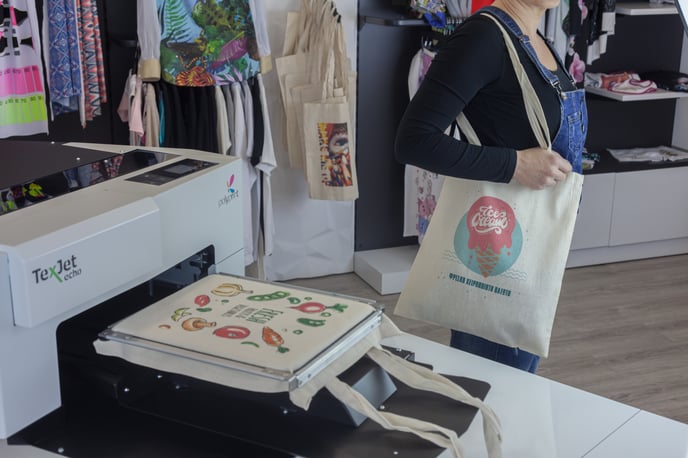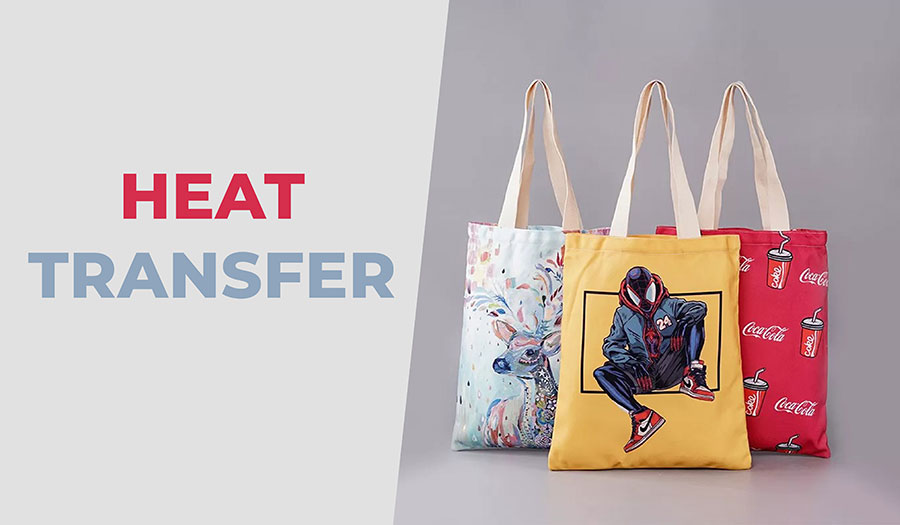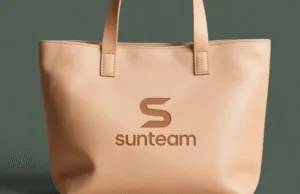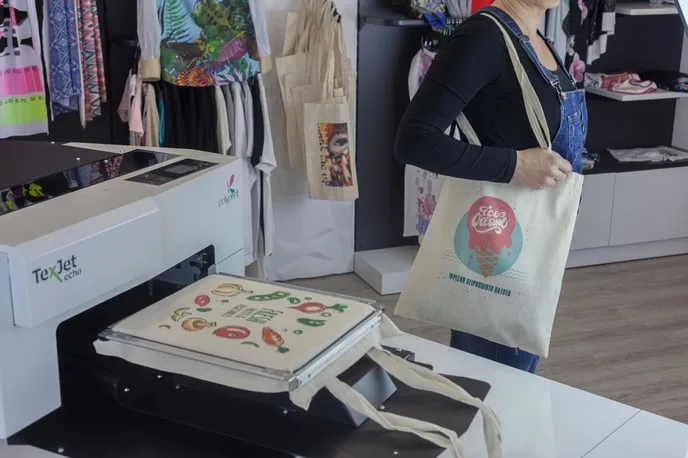Why Do Some Custom Tote Bags Last While Others Fade Quickly? The key lies in the choice of printing technique. Screen printing delivers vibrant, long-lasting colors, while direct-to-garment (DTG) and embroidery offer unique textures and greater flexibility. Each method has its pros and cons, but a single detail can often determine the success or failure of the final result — from ink penetration depth to fabric compatibility, every step can impact the durability and overall appearance of the tote bag.
1. Screen Printing for Custom Tote Bags
Expert Opinion:
“Screen printing is the top choice for decorating tote bags to make them last. I have over 15 years of experience in textile printing. I’ve seen that screen prints, when cured the right way, keep their bright colors after hundreds of washes. The main reason is the ink. Screen printing applies a thicker, more solid ink layer than other methods. This is vital for bags that get heavy use, like grocery totes or promotional items. Setup costs may look high at first. But I believe the long-term value is clear. For brands wanting to make a lasting impression, I strongly suggest screen printing. It offers bright colors, great durability, and is cost-effective for large orders.Newer technologies can’t match this overall package.”
———— Marcus Chen , Textile Printing Specialist and Technical Director at the Textile Printing Association
Screen printing is a historic and versatile printing technique that dates back thousands of years, with roots tracing to ancient China. Over time, it evolved into a popular method for applying bold, vibrant designs on various materials, including fabrics. Today, it is widely used for custom tote bags, especially when bright and lively colors are desired. The process involves creating a stencil or screen, through which ink is pressed onto the fabric layer by layer. Each color requires its own screen, allowing for precise and vivid prints.
A high-quality screen ensures excellent color retention and sharpness, even after repeated washing, resulting in durable and long-lasting designs. Screen printing is particularly cost-effective for large orders—typically over 100 bags—where the per-unit cost can decrease by about 70% compared to other printing methods. Despite the preparation requiring careful setup of screens, emulsions, and exact alignment of each bag, the outcome delivers superior print quality that stands out.
Custom printed tote bags created through screen printing are popular in various settings, from promotional giveaways and retail merchandise to artisan markets and events. Their durability and eye-catching appearance make them ideal for brands seeking to increase visibility and create a memorable impression. The method’s rich history combined with its practical advantages continues to make screen printing a preferred choice for fabric decoration worldwide.
Advantages and Disadvantages of Screen Printing on Tote Bags

Silk screen printing on tote bags offers several advantages. Firstly, the print quality is outstanding, with vibrant colors and strong coverage that remain striking even on dark-colored bags. When using plastisol ink, the colors are opaque and rich, making it easy to match Pantone colors accurately. The printing details are fine and precise, resulting in a professional overall appearance, which is ideal for brands seeking high-quality prints. Secondly, screen printing is cost-effective for large production runs, especially for designs with fewer colors, making it suitable for events, giveaways, and commercial purposes. Additionally, the printed patterns are durable and washable; once cured, the ink adheres firmly and resists fading or cracking even after multiple uses. Screen printing works well on materials such as cotton and non-woven bags with large, flat surfaces, and when combined with water-based inks, it offers a soft hand feel, especially on 100% cotton totes. Finally, different ink types can be chosen according to needs—water-based inks are eco-friendly, breathable, and soft to the touch, ideal for projects focusing on sustainability and texture, while plastisol inks provide stronger color fastness, ease of use, and a longer shelf life, catering to diverse printing requirements.
The drawbacks of screen printing on tote bags mainly lie in its relatively complex process, which requires preparing various tools and materials such as screen frames, exposure units, printing platens, adhesive sprays, and cardboard inserts. The screen-making process involves multiple steps including design creation, emulsion coating, exposure, and washing, making the initial preparation time-consuming and complicated. Additionally, the equipment investment is relatively high, as specialized items like aluminum screen frames, exposure machines, and drying ovens are needed, and tote bag screen frames differ from those used for T-shirts, requiring separate setups. Screen printing is not ideal for multi-color or intricate designs since multi-color printing requires separate screens, increasing difficulty in alignment and overall costs. For small batches or highly detailed, multi-color orders, digital printing is more flexible. Ink type limitations also exist; water-based inks have shorter shelf lives, require careful storage and handling, and can clog screens if not managed properly. Products requiring high water resistance may need additional treatment or alternative inks. Furthermore, precise positioning during printing is critical—if the tote bag is not centered on the platen or the design isn’t reversed before printing, misalignment or design errors can occur. Before the ink fully cures, prints may also smudge or bleed through to the backside of the bag.
2. Direct to Garment (DTG) Printing for Custom Tote Bags
The first encounter with a DTG printer happened in a small Brooklyn studio, where the machine moved precisely across the cotton, applying layers of vivid color. The result was striking—almost photographic in detail. Unlike traditional methods, DTG printing requires no messy screens or extensive setup. Instead, the design is simply uploaded, and the printer applies water-based ink directly onto the tote. For any tote bag supplier seeking flexibility in design and small-batch customization, DTG offers a powerful solution that bridges creativity and efficiency.
Because of this streamlined process, it’s possible to print just one bag or a hundred with equal ease. Furthermore, design files can be updated quickly for each new order, making the method ideal for customization. However, printing on dark totes tends to be more expensive due to the additional white ink required—averaging around $2 per image, compared to just $0.20 on white fabric. Nevertheless, the sharp detail and vibrant color often justify the added cost.
For example, when 50 event bags needed to be personalized with individual portraits, DTG enabled fast and detailed tote bag production—completing the entire batch in just one day. This demonstrates how DTG excels in handling small runs of intricate tote bag designs efficiently and effectively.
My Take on Pros and Cons of DTG for Custom Tote Bags

| Pros | Cons |
|---|---|
| You can print any number of colors, including photos and gradients. | Printing large batches is slower compared to screen printing. |
| There’s no minimum order, which is cost-efficient for single items or samples. | The ink cost is higher for dark bags because they need extra white ink. |
| It’s ideal, in my view, for on-demand sales, personalized gifts, and e-commerce. | For the best quality, pretreatment and humidity control are necessary. |
| Swapping files is quick, and there’s low manual setup. | It works best with cotton. Results can vary on synthetic materials. |
| There’s minimal labor involved per order. | Durability is good, but not as tough as screen print for heavy, frequent use. |
3. Heat Transfer Printing for Tote Bags

Heat Transfer Printing is a very flexible way to print on tote bags. This method uses heat and pressure. This transfers your design onto the fabric. For some custom tote bags, you use Heat Transfer Vinyl (HTV). Printable heat transfer paper is another option. You might even try sublimation for certain types of tote bags.
Types of Heat Transfer Methods & My Thoughts on Their Features
HTV: HTV is to be very durable. It comes in many colors and effects. It’s great for bold, simple logos or layered designs.
Printable Heat Transfer Paper: This is for photo-like, full-color designs. It offers a lot of creative freedom.
Sublimation: This is best for polyester or treated canvas. It gives permanent, bright images that become part of the fabric.
Before starting any large-scale tote bag production, it is highly recommended to press a sample design onto a spare tote bag. In one instance, this step helped identify ghosting lines on the test piece, preventing the waste of an entire batch of around two dozen bags.
Ensuring the tote bag is stretched completely flat during pressing is critical. Even a single wrinkle can distort the graphic, leading to subpar results. Maintaining a smooth and taut surface consistently improves transfer quality.
Following the specific instructions for each heat transfer vinyl (HTV) product is essential. Different HTV formulations require varying pressing times and temperatures. For example, an off-brand HTV was found to need 30 seconds of pressing, double the typical 15 seconds, to achieve proper adhesion.
Prepressing the tote bag before applying the transfer is an important preparatory step. It removes moisture and creates a smooth surface, which enhances adhesion. Observations from multiple projects indicate that pre-pressing can increase the durability and stickiness of the design by approximately 30%, compared to cases where this step was omitted.
My View on Pros & Cons of Heat Transfer Printing for Tote Bags
| Pros | Cons |
|---|---|
| Great for small batches or one-off personalized totes | Not ideal for large-scale production — each bag must be placed and pressed manually |
| Supports full-color and complex images using transfer paper or sublimation | Sublimation requires polyester-coated bags, limiting fabric choices |
| Produces strong, vivid, and textured prints with HTV | Designs may peel or fade if washed improperly or pressed with incorrect heat/pressure |
4. What is Sublimation Heat Transfer Printing

Sublimation heat transfer printing is an advanced printing technology that uses heat to transfer special dyes directly onto fabric. This process involves heating sublimation dyes to convert them from solid to gas, allowing the dye to penetrate the fibers and bond with the material. The result is vibrant, durable, and naturally soft designs that become an integral part of the fabric. For any manufacturer of custom tote bags, sublimation printing offers an ideal solution for achieving full-color, long-lasting graphics that won’t fade, crack, or peel over time.
The key principle behind sublimation printing is the gasification of the dye and its bonding with polyester or polymer-coated substrates. Because the dye penetrates deeply into the fibers, the printed designs resist fading and peeling caused by washing or friction, ensuring long-lasting durability.
Typical Sublimation Printing Workflow
1. Design the artwork and print it in mirror image on sublimation transfer paper using sublimation inks.
2. Pre-press the tote bag to remove moisture and check the fabric’s heat tolerance.
3. Place the printed transfer paper onto the tote bag surface; use a protective sheet such as Teflon or parchment paper to safeguard both the fabric and the heat press machine if necessary.
4. Apply even pressure with the heat press to transfer the dye into the fabric fibers.
5. Allow the tote bag to cool completely before peeling off the transfer paper to reveal a crisp, durable print.
Professional Recommendations
Always verify the material of the custom tote bag to avoid low-quality fabrics that may melt under high temperatures.
Use tote bags labeled as suitable for sublimation or those with a high polyester content to ensure optimal print quality.
Protect your heat press machine and prints by covering them with protective sheets during pressing.
Precisely control temperature and pressure to achieve vibrant colors and sharp design details.
Pros & Cons of Sublimation Printing for Tote Bags
| Pros | Cons |
|---|---|
| Print becomes part of the fabric — no cracking, peeling, or fading | Works best on white or light-colored polyester or coated totes — not suitable for cotton or dark bags |
| Produces bright, extremely durable images — ideal for frequent, heavy use | Some bag linings (e.g., vinyl) may melt or clump under high temperatures |
| Excellent for custom gifts, promos, and everyday totes for shopping, school, or beach trips | Low-quality tote bags may not withstand the high heat required for sublimation |
Summary: Sublimation printing gives you professional-looking, bright, and long-lasting results on polyester tote bags. I’d say it’s a fantastic option if your bag material works with it and you want a colorful, durable finish.
5. Heat Transfer Vinyl (HTV) for Tote Bags

For bag suppliers, Heat Transfer Vinyl (HTV) offers a versatile and efficient customization solution. HTV is compatible with various bag materials such as cotton, canvas, and non-woven fabrics, producing vibrant colors and sharp, detailed designs. This technique is especially suitable for small batch and personalized orders, enabling suppliers to quickly respond to market demands and add value to their products. By carefully controlling temperature, pressure, and time, HTV designs adhere firmly, ensuring durability and consistent quality. For bag manufacturers looking to expand customization options and meet diverse customer needs, HTV provides an economical and practical printing method.
Review from BagzDepot:
“Canvas tote bags are the perfect accessory to help you carry your personal items. They’re widely available with all kinds of different designs and styles, but an avid decorator or someone with specific taste will no doubt want to customize their own.”
Cons of HTV for Tote Bags
It’s not very cost-effective for large production runs. This is because cutting, weeding, and pressing each piece takes manual labor.
Designs with many colors or a lot of detail need careful layering. This can make the process slower and you might make more mistakes.
The transfers have a somewhat raised vinyl feel. Also, the printed area won’t breathe as well as screen prints or DTG prints.
6. Embossing / Debossing of Custom Tote Bag

Embossing and debossing are premium finishing techniques that elevate the look and feel of custom tote bags. Embossing creates a raised design on the surface, while debossing presses the design into the material, forming a recessed impression. Both techniques are commonly used on leather or high-quality synthetic materials to showcase logos, monograms, or branding elements with subtle elegance.
These methods do not require inks or foils, making them ideal for a clean, sophisticated aesthetic. Embossed and debossed designs are durable, tactile, and timeless, often used in luxury bags to convey quality and craftsmanship. For custom tote bags, this technique adds a unique identity while maintaining a minimalist style. Brands that value understated elegance and long-lasting detail often prefer embossing or debossing over traditional printing.
Summary
Picking the right printing method for tote bags requires understanding specific needs. For prints that last a long time, screen printing is highly recommended due to its durability. For greater design flexibility, DTG (Direct to Garment) printing offers excellent options. When cost-efficiency is a priority, heat transfer provides a budget-friendly solution. For a top-quality, professional appearance, embroidery is often the best choice. Each method suits particular situations. Matching the printing technique with budget, order quantity, and design complexity is crucial for optimal results. Investing time to understand the benefits and limitations of each method before starting production will ensure that tote bags look exceptional from the start and maintain a lasting impression.
From fast-moving promotions to premium gifts, choosing the right printing method can turn your tote bag from a throwaway item into a long-term brand ambassador.
Need a tailored solution? Contact us for a free consultation on the best printing options. You’ll receive a complete quote, matched to your budget and needs, within 24 hours.

